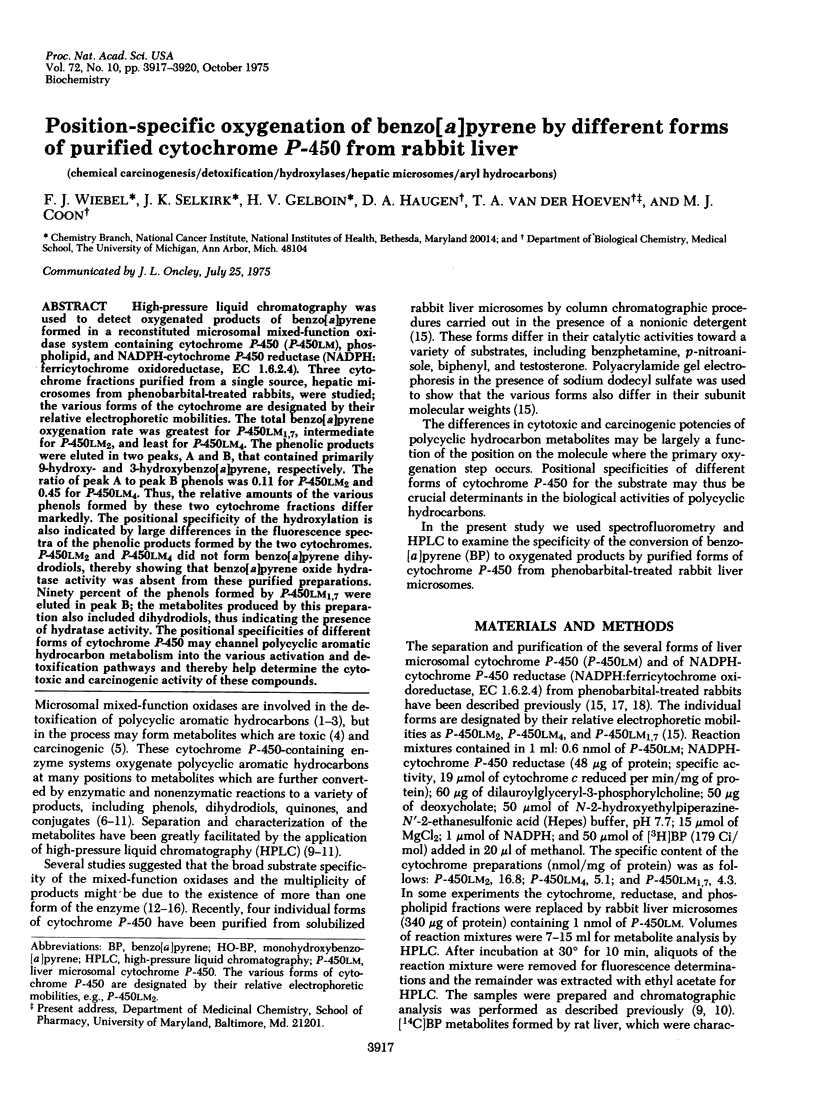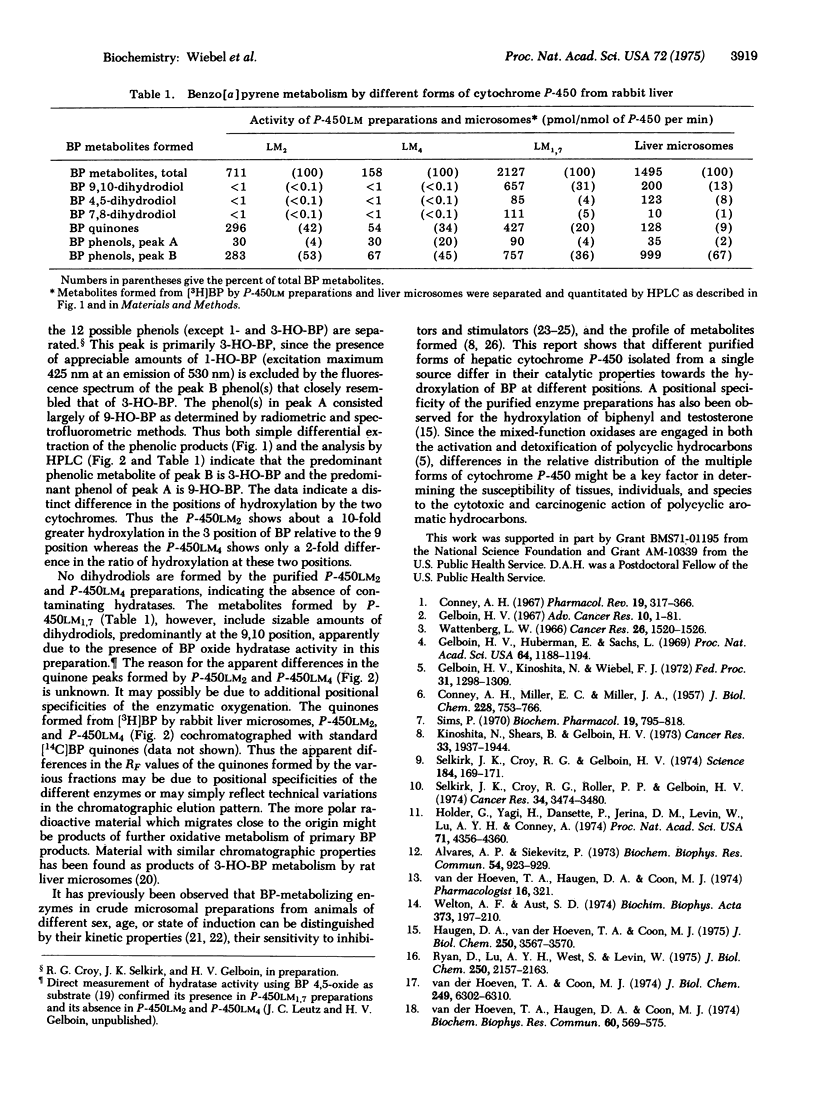Abstract
High-pressure liquid chromatography was used to detect oxygenated products of benzo[a]pyrene formed in a reconstituted microsomal mixed-function oxidase system containing cytochrome P-450 (P-450LM), phospholipid, and NADPH-cytochrome P-450 reductase (NADPH: ferricytochrome oxidoreductase, EC 1.6.2.4). Three cytochrome fractions purified from a single source, hepatic microsomes from phenobarbital-treated rabbits, were studied; the various forms of the cytochrome are designated by their relative electrophoretic mobilities. The total benzo[a]pyrene oxygenation rate was greatest for P-450LM1,7, intermediate for P-450LM2, and least for P-450LM4. The phenolic products were eluted in two peaks, A and B, that contained primarily 9-hydroxy- and 3-hydroxybenzo[a]pyrene, respectively. The ratio of peak A to peak B phenols was 0.11 for P-450LM2 and 0.45 for P-450LM4. Thus, the relative amounts of the various phenols formed by these two cytochrome fractions differ markedly. The positional specificity of the hydroxylation is also indicated by large differences in the fluorescence spectra of the phenolic products formed by the two cytochromes. P-450LM2 and P-450LM4 did not form benzo[a]pyrene dihydrodiols, thereby showing that benzo[a]pyrene oxide hydratase activity was absent from these purified preparations. Ninety percent of the phenols formed by P-450LM1,7 were eluted in peak B; the metabolites produced by this preparation also included dihydrodiols, thus indicating the presence of hydratase activity. The positional specificities of different forms of cytochrome P-450 may channel polycyclic aromatic hydrocarbon metabolism into the various activation and detoxification pathways and thereby help determine the cytotoxic and carcinogenic activity of these compounds.
Full text
PDF



Selected References
These references are in PubMed. This may not be the complete list of references from this article.
- Alvares A. P., Schilling G. R., Kuntzman R. Differences in the kinetics of benzpyrene hydroxylation by hepatic drug-metabolizing enzymes from phenobarbital and 3-methylcholanthrene-treated rats. Biochem Biophys Res Commun. 1968 Mar 12;30(5):588–593. doi: 10.1016/0006-291x(68)90094-6. [DOI] [PubMed] [Google Scholar]
- Alvares A. P., Siekevitz P. Gel electrophoresis of partially purified cytochromes P450 from liver microsomes of variously-treated rats. Biochem Biophys Res Commun. 1973 Oct 1;54(3):923–929. doi: 10.1016/0006-291x(73)90782-1. [DOI] [PubMed] [Google Scholar]
- CONNEY A. H., MILLER E. C., MILLER J. A. Substrate-induced synthesis and other properties of benzpyrene hydroxylase in rat liver. J Biol Chem. 1957 Oct;228(2):753–766. [PubMed] [Google Scholar]
- Conney A. H. Pharmacological implications of microsomal enzyme induction. Pharmacol Rev. 1967 Sep;19(3):317–366. [PubMed] [Google Scholar]
- Gelboin H. V. Carcinogens, enzyme induction, and gene action. Adv Cancer Res. 1967;10:1–81. doi: 10.1016/s0065-230x(08)60076-7. [DOI] [PubMed] [Google Scholar]
- Gelboin H. V., Huberman E., Sachs L. Enzymatic hydroxylation of benzopyrene and its relationship to cytotoxicity. Proc Natl Acad Sci U S A. 1969 Dec;64(4):1188–1194. doi: 10.1073/pnas.64.4.1188. [DOI] [PMC free article] [PubMed] [Google Scholar]
- Gelboin H. V., Kinoshita N., Wiebel F. J. Microsomal hydroxylases: induction and role in polycyclic hydrocarbon carcinogenesis and toxicity. Fed Proc. 1972 Jul-Aug;31(4):1298–1309. [PubMed] [Google Scholar]
- Gurtoo H. L., Campbell T. C. A kinetic approach to a study of the induction of rat liver microsomal hydroxylase after pretreatment with 3,4-benzpyrene and aflatoxin B 1 . Biochem Pharmacol. 1970 May;19(5):1729–1735. doi: 10.1016/0006-2952(70)90164-4. [DOI] [PubMed] [Google Scholar]
- Haugen D. A., van der Hoeven T. A., Coon M. J. Purified liver microsomal cytochrome P-450. Separation and characterization of multiple forms. J Biol Chem. 1975 May 10;250(9):3567–3570. [PubMed] [Google Scholar]
- Holder G., Yagi H., Dansette P., Jerina D. M., Levin W., Lu A. Y., Conney A. H. Effects of inducers and epoxide hydrase on the metabolism of benzo(a)pyrene by liver microsomes and a reconstituted system: analysis by high pressure liquid chromatography. Proc Natl Acad Sci U S A. 1974 Nov;71(11):4356–4360. doi: 10.1073/pnas.71.11.4356. [DOI] [PMC free article] [PubMed] [Google Scholar]
- Kinoshita N., Shears B., Gelboin H. V. K-region and non-K-region metabolism of benzo(a)pyrene by rat liver microsomes. Cancer Res. 1973 Aug;33(8):1937–1944. [PubMed] [Google Scholar]
- Leutz J. C., Gelboin H. V. Benzo(a)pyrene-4,5-oxide hydratase: assay, properties, and induction. Arch Biochem Biophys. 1975 Jun;168(2):722–725. doi: 10.1016/0003-9861(75)90307-0. [DOI] [PubMed] [Google Scholar]
- Nebert D. W., Gelboin H. V. Substrate-inducible microsomal aryl hydroxylase in mammalian cell culture. I. Assay and properties of induced enzyme. J Biol Chem. 1968 Dec 10;243(23):6242–6249. [PubMed] [Google Scholar]
- Rasmussen R. E., Wang I. Y. Dependence of specific metabolism of benzo(a)pyrene on the inducer of hydroxylase activity. Cancer Res. 1974 Sep;34(9):2290–2295. [PubMed] [Google Scholar]
- Ryan D., Lu A. Y., West S., Levin W. Multiple forms of cytochrome P-450 in phenobarbital- and 3-methylcholanthrene-treated rats. Separation and spectral properties. J Biol Chem. 1975 Mar 25;250(6):2157–2163. [PubMed] [Google Scholar]
- Selkirk J. K., Croy R. G., Gelboin H. V. Benzo(a)pyrene metabolites: efficient and rapid separation by high-pressure liquid chromatography. Science. 1974 Apr 12;184(4133):169–171. doi: 10.1126/science.184.4133.169. [DOI] [PubMed] [Google Scholar]
- Selkirk J. K., Croy R. G., Roller P. P., Gelboin H. V. High-pressure liquid chromatographic analysis of benzo(alpha)pyrene metabolism and covalent binding and the mechanism of action of 7,8-benzoflavone and 1,2-epoxy-3,3,3-trichloropropane. Cancer Res. 1974 Dec;34(12):3474–3480. [PubMed] [Google Scholar]
- Sims P. Qualitative and quantitative studies on the metabolism of a series of aromatic hydrocarbons by rat-liver preparations. Biochem Pharmacol. 1970 Mar;19(3):795–818. doi: 10.1016/0006-2952(70)90243-1. [DOI] [PubMed] [Google Scholar]
- Wattenberg L. W. Chemoprophylaxis of carcinogenesis: a review. Cancer Res. 1966 Jul;26(7):1520–1526. [PubMed] [Google Scholar]
- Welton A. F., Aust S. D. The effects of 3-methylcholanthrene and phenobarbital induction on the structure of the rat liver endoplasmic reticulum. Biochim Biophys Acta. 1974 Dec 10;373(2):197–210. doi: 10.1016/0005-2736(74)90145-x. [DOI] [PubMed] [Google Scholar]
- Wiebel F. J., Gelboin H. V. Aryl hydrocarbon (benzo[a]pyrene) hydroxylases in liver from rats of different age, sex and nutritional status. Distinction of two types by 7,8-benzoflavone. Biochem Pharmacol. 1975 Aug 15;24(16):1511–1515. doi: 10.1016/0006-2952(75)90028-3. [DOI] [PubMed] [Google Scholar]
- Wiebel F. J., Leutz J. C., Diamond L., Gelboin H. V. Aryl hydrocarbon (benzo(a)pyrene) hydroxylase in microsomes from rat tissues: differential inhibition and stimulation by benzoflavones and organic solvents. Arch Biochem Biophys. 1971 May;144(1):78–86. doi: 10.1016/0003-9861(71)90456-5. [DOI] [PubMed] [Google Scholar]
- van der Hoeven T. A., Coon M. J. Preparation and properties of partially purified cytochrome P-450 and reduced nicotinamide adenine dinucleotide phosphate-cytochrome P-450 reductase from rabbit liver microsomes. J Biol Chem. 1974 Oct 10;249(19):6302–6310. [PubMed] [Google Scholar]
- van der Hoeven T. A., Haugen D. A., Coon M. J. Cytochrome P-450 purified to apparent homogeneity from phenobarbital-induced rabbit liver microsomes: catalytic activity and other properties. Biochem Biophys Res Commun. 1974 Sep 23;60(2):569–575. doi: 10.1016/0006-291x(74)90278-2. [DOI] [PubMed] [Google Scholar]


